A Japanese spacecraft will give people an opportunity to land their name on an asteroid. Due for launch near the end of this year, the MUSES-C spacecraft will meet up with asteroid 1998 SF36 when it crosses the Earth’s orbit in 2005. It will land on the asteroid, collect samples which it will later return to Earth. As part of its mission, the spacecraft will deposit an aluminium foil sheet containing the names of hundreds of thousands of space enthusiasts. If you want to get your name on board, you have until July 5th.
Thunderstorms Delay Shuttle Landing
Flight controllers decided to wave two landing attempts of the space shuttle Endeavour on Monday because of thunderstorms threatening the Cape Canaveral landing area. The shuttle will try again on Tuesday, but forecasters are predicting poor weather then too. Alternatively, the shuttle can land at Edward’s Air Force Base in California; however, it’s a more expensive option as Endeavour will need to be returned to Florida. The first landing attempt on Tuesday is scheduled for 1555 GMT (11:55am EDT).
New Planetary System has Familiar Feel
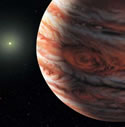
Image credit: NASA
Planet hunters have discovered a new extrasolar system that looks remarkable like our own Solar System. Until now, planets orbiting around other stars have had elongated and eccentric orbits, but a planet orbiting around 55 Cancri has almost the same distance as our own Jupiter (although, it does have 3.5-5 times the mass). The team of astronomers also announced an additional 13 new planets on the same day, bringing the total number of known planets outside our Solar System to over 90.
After 15 years of observation and a lot of patience, the world’s premier planet-hunting team has finally found a planetary system that reminds them of our own home solar system.
Dr. Geoffrey Marcy, astronomy professor at the University of California, Berkeley, and astronomer Dr. Paul Butler of the Carnegie Institution of Washington, Washington, D.C., today announced the discovery of a Jupiter-like planet orbiting a Sun-like star at nearly the same distance as the Jovian system orbits our Sun.
“All other extrasolar planets discovered up to now orbit closer to the parent star, and most of them have had elongated, eccentric orbits. This new planet orbits as far from its star as our own Jupiter orbits the Sun,” said Marcy. NASA and the National Science Foundation fund the planet-hunting team.
The star, 55 Cancri in the constellation Cancer, was already known to have one planet, announced by Butler and Marcy in 1996. That planet is a gas giant slightly smaller than the mass of Jupiter and whips around the star in 14.6 days at a distance only one-tenth that from Earth to the Sun.
Using as a yardstick the 93-million mile Earth-Sun distance, called an astronomical unit or AU, the newfound planet orbits at 5.5 AU, comparable to Jupiter’s distance from our Sun of 5.2 AU (about 824 million kilometers or 512 million miles). Its slightly elongated orbit takes it around the star in about 13 years, comparable to Jupiter’s orbital period of 11.86 years. It is 3.5 to 5 times the mass of Jupiter.
“We haven’t yet found an exact solar system analog, which would have a circular orbit and a mass closer to that of Jupiter. But this shows we are getting close, we are at the point of finding planets at distances greater than 4 AU from the host star,” said Butler. “I think we will be finding more of them among the 1,200 stars we are now monitoring.”
The team shared its data with Dr. Greg Laughlin, assistant professor of astronomy and astrophysics at the University of California, Santa Cruz. His dynamical calculations show that an Earth-sized planet could survive in a stable orbit between the two gas giants. For the foreseeable future, existence of any such planet around 55 Cancri will remain speculative.
“The existence of analogs to our solar system adds urgency to missions capable of detecting Earth-sized planets – first the Space Interferometry Mission and then the Terrestrial Planet Finder,” said Dr. Charles Beichman, NASA’s Origins Program chief scientist at the agency’s Jet Propulsion Laboratory, Pasadena, Calif.
“This planetary system will be the best candidate for direct pictures when the Terrestrial Planet Finder is launched later this decade,” said UC Berkeley astronomer Dr. Debra A. Fischer.
Marcy, Butler, Fischer and their team also announced a total of 13 new planets today, including the smallest ever detected: a planet circling the star HD49674 in the constellation Auriga at a distance of .05 AU, one-twentieth the distance from Earth to the Sun. Its mass is about 15 percent that of Jupiter and 40 times that of Earth. This brings the number of known planets outside our solar system to more than 90.
Discovery of a second planet orbiting 55 Cancri culminates 15 years of observations with the 3-meter (118-inch) telescope at Lick Observatory, owned and operated by the University of California. The team also includes Dr. Steve Vogt, University of California, Santa Cruz; Dr. Greg Henry, Tennessee State University, Nashville; and Dr. Dimitri Pourbaix, the Institut d’Astronomie et d’Astrophysique, Universit? Libre de Bruxelles.
The star 55 Cancri is 41 light years from Earth and is about 5-billion years old. Further data are needed to determine whether yet another planet is orbiting it, because the two known planets do not explain all the observed Doppler wobbling. One possible explanation is a Saturn-mass planet orbiting about .24 AU from the star.
Original Source: NASA/JPL News Release
Sea Launch Delivers PanAmSat to Orbit
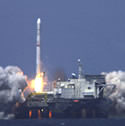
Image credit: Sea Launch
A Zenit-3SL successfully carried a PanAmSat’s Galaxy IIIC satellite into orbit on Saturday, marking the seventh launch from the floating Sea Launch platform. The three-stage rocket lifted off from the platform on Saturday at 2239 GMT (6:39pm EDT), and the spacecraft’s signal was detected a few minutes later, indicating a successful launch. The satellite will move to a geostationary orbit, where it will provide Internet, video, audio and data services to North America.
A Sea Launch rocket today successfully launched PanAmSat’s Galaxy IIIC satellite into orbit. Marking Sea Launch’s seventh successful mission, the three-stage rocket lifted off at 3:39:30 P.M. PDT from the Odyssey Launch Platform, positioned on the Equator. As planned, the spacecraft’s first signal was acquired shortly after spacecraft separation, at 4:47:00 p.m. PDT.
Built by Boeing Satellite Systems, the 10,692 lb. (4850 kg) 702 model spacecraft is designed for a 15 year lifespan in Geostationary Orbit. The satellite will provide Internet, video, audio and data services to the United States and Latin America.
“The launch of Galaxy IIIC commemorates the second time Sea Launch has successfully placed a PanAmSat satellite in orbit,” said Jim Maser, president of Sea Launch. “Our international team has recognized PanAmSat’s continued confidence in our launch performance and we look forward to working with them again in the near future.”
The Zenit-3SL vehicle lifted off from the Odyssey Launch Platform on schedule from the equatorial launch site at 154 degrees West Longitude. All systems performed nominally throughout the flight. The Block DM upper stage separated from the spacecraft about 1,385 miles above the Indian Ocean, 61 minutes after liftoff. Operators acquired a signal from Galaxy IIIC from a ground station in Western Australia. Galaxy IIIC will have a final position in Geostationary Orbit at 95 degrees West Longitude.
PanAmSat is a leading provider of global video and data broadcasting services via satellite. The company builds, owns and operates networks that deliver entertainment and information to cable television systems, TV broadcast affiliates, direct-to-home TV operators, telecommunications companies and corporations. Based in Wilton, Conn., PanAmSat has one of the world’s largest commercial geostationary satellite networks.
Sea Launch Company, LLC, based in Long Beach, Calif., provides reliable, cost-effective, heavy lift launch services for commercial satellite customers. The international members include Boeing (U.S.), Kvaerner (Norway), RSC Energia (Russia) and SDO Yuzhnoye / PO Yuzhmash (Ukraine). Established in 1995, Sea Launch has a current backlog of 17 firm launch contracts. As the world’s only services provider launching from the Equator, Sea Launch offers the optimal starting point for spacecraft heading to Geostationary Orbit. For additional information, visit the Sea Launch website at www.sea-launch.com.
Original Source: Boeing News Release
Hubble Reveals Retina Nebula
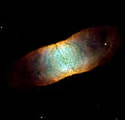
Image credit: Hubble
The most recently released photograph taken by the Hubble Space Telescope is of wispy nebula IC 4406, dubbed the “Retina Nebula”. The object is a ring of dust and gas around a dying star and is nearly perfectly symmetrical. One of the more interesting features is the lattice of dark lanes that crisscross the centre of the nebula, each of which is 160 astronomical units wide (1 AU is the distance from the Earth to the Sun). The photograph is a composite of images taken in June 2001 and January 2002.
A dying star, IC 4406, dubbed the “Retina Nebula” is revealed in this month’s Hubble Heritage image.
Like many other so-called planetary nebulae, IC 4406 exhibits a high degree of symmetry; the left and right halves of the Hubble image are nearly mirror images of the other. If we could fly around IC 4406 in a starship, we would see that the gas and dust form a vast donut of material streaming outward from the dying star. From Earth, we are viewing the donut from the side. This side view allows us to see the intricate tendrils of dust that have been compared to the eye’s retina. In other planetary nebulae, like the Ring Nebula (NGC 6720), we view the donut from the top.
The donut of material confines the intense radiation coming from the remnant of the dying star. Gas on the inside of the donut is ionized by light from the central star and glows. Light from oxygen atoms is rendered blue in this image; hydrogen is shown as green, and nitrogen as red. The range of color in the final image shows the differences in concentration of these three gases in the nebula.
Unseen in the Hubble image is a larger zone of neutral gas that is not emitting visible light, but which can be seen by radio telescopes.
One of the most interesting features of IC 4406 is the irregular lattice of dark lanes that criss-cross the center of the nebula. These lanes are about 160 astronomical units wide (1 astronomical unit is the distance between the Earth and Sun). They are located right at the boundary between the hot glowing gas that produces the visual light imaged here and the neutral gas seen with radio telescopes. We see the lanes in silhouette because they have a density of dust and gas that is a thousand times higher than the rest of the nebula. The dust lanes are like a rather open mesh veil that has been wrapped around the bright donut.
The fate of these dense knots of material is unknown. Will they survive the nebula’s expansion and become dark denizens of the space between the stars or simply dissipate?
This image is a composite of data taken by Hubble’s Wide Field Planetary Camera 2 in June 2001 by Bob O’Dell (Vanderbilt University) and collaborators and in January 2002 by The Hubble Heritage Team (STScI). Filters used to create this color image show oxygen, hydrogen, and nitrogen gas glowing in this object.
Original Source: Hubble News Release
Endeavour Undocks from the Station
The space shuttle Endeavour undocked from the International Space Station on Saturday and prepared to return a team of astronauts who broke the American space endurance record – the crew of Expedition 4 will have been in space for 194 days when the shuttle returns to Florida on Monday. The new crew of two Russians and one American will remain on board the station until October.
Second Spacewalk Goes Well
During a 5-hour spacewalk, astronauts Franklin Chang-D?az and Philippe Perrin completed installation of the Mobile Remote Servicer Base System on the International Space Station’s Mobile Transporter. This gives the Canadarm2 the ability to move around the station, assisting with construction and maintenance. The astronauts will perform their third and final spacewalk on Thursday to replace the Canadarm2’s wrist joint.
In a 5-hour spacewalk today, Endeavour astronauts Franklin Chang-D?az and Philippe Perrin completed installation of the Mobile Remote Servicer Base System, or MBS, on the International Space Station?s railcar, the Mobile Transporter. With those tasks completed, they established a moveable base for future use by the station?s robotic arm, Canadarm2.
Chang-D?az and Perrin ventured outside the station?s Quest airlock at 10:20 a.m. Central time. With the help of Pilot Paul Lockhart, who guided the spacewalk from inside the shuttle, Chang-D?az and Perrin first connected primary and backup cables for video and data, and primary power cables between the Mobile Transporter railcar and the MBS. Once the connections were made, ground controllers sent commands for the MT to remotely plug in its umbilical attachments to receptacles on the S0 (S-Zero) truss railway.
With that complete, Chang-D?az and Perrin then deployed an auxiliary grapple fixture on the MBS called the Payload Orbital Replacement Unit Accommodation, or POA, and placed it in its final configuration. Identical to the end effectors on Canadarm2, the fixture can grapple payloads and hold them as they are moved along the station?s truss atop the MBS.
Continuing to run ahead of schedule, the two spacewalkers then secured four bolts between the MBS and the railcar, completing installation of the new MBS platform. Later this month or next, Canadarm2 will ?walk off? the Destiny Laboratory and mate its free hand to any one of four power and data fixtures on the new platform so it can be driven up and down the length of the station?s truss for use in future station assembly and maintenance operations.
The spacewalkers then relocated a television camera to its final position on top of a mast atop the MBS. The camera will provide views of station assembly and maintenance operations to ground controllers. Final tasks included adding an extra extension cable for the platform, a wire tie to one of the cables installed earlier during the spacewalk and to photograph connectors near the lower portion of the MBS that tie into the MT.
Following an inventory of the tools they used during the spacewalk, Perrin and Chang-D?az re-entered Quest. Airlock repressurization began at 3:20 p.m. Central time, signaling the end of the spacewalk. It was the 40th spacewalk in support of ISS assembly and maintenance and the second of the mission, bringing the total spacewalking time for STS-111 to 12 hours and 14 minutes.
After flight controllers verified that all connections on the Mobile Remote Servicer Base System were working properly, the capture latch on Canadarm2 was released. The arm, which had been supplying power to the MBS, was then repositioned for Thursday?s third and final spacewalk of the mission, which will see replacement of its wrist roll joint.
Handover conferences between the two Expedition crews and the transfer of equipment and supplies to the Leonardo Multi-Purpose Logistics Module also continued today. Working ahead of schedule, the crew continued to refill the module with unneeded supplies to be returned to Earth.
At 9:19 Central time tonight, Endeavour crewmembers and former Expedition Four Flight Engineers Carl Walz and Dan Bursch will set a new U.S. space endurance record, exceeding Shannon Lucid?s record of 188 consecutive days spent in space. Walz will set another record in the process, exceeding Lucid?s U.S. record for cumulative days spent in space as he reaches 223 days accrued over the course of five flights. Expedition 4 Commander Yury Onufrienko has spent a total 381 days in space, but remains far behind the world record for time in space of 747 days, held by Sergei Avdeyev.
The next STS-111 status report will be issued Wednesday morning after crew wakeup, or earlier, if events warrant.
Original Source: NASA News Release
ESO Captures Image of Tarantula Nebula
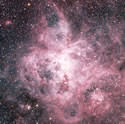
Image credit: ESO
The latest image released from the European Southern Observatory is of the Tarantula Nebula, located in the Large Magellanic Cloud approximately 170,000 light years from here. The nebula measures more than 1,000 light years across and covers the same amount of sky as the Moon. The image is a composite made up of 15 individual exposures taken with the 2.2m telescope at La Silla Observatory in Chile.
The largest emission nebula in the sky, the Tarantula Nebula (also known as NGC 2070 or 30 Doradus) is located in the Large Magellanic Cloud (LMC), one of the satellite galaxies to our own Milky Way system. Seen far down in the southern sky at a distance of about 170,000 light-years, this beautiful nebula measures more than 1000 light-years across and extends over more than one third of a degree, almost, but not quite the size of the full moon. It received its descriptive name because of the unusual shape.
It is a splendid object with a central cluster of hot and luminous young stars that powers strong emission from hydrogen and oxygen gas, making the Tarantula Nebula an easy and impressive target for observations, even with the unaided eye. It is well visible from ESO’s mountain observatories at La Silla and Paranal in Chile and it has been the object of innumerable research programmes with many different telescopes.
The present images of the Tarantula Nebula were obtained with the Wide-Field Imager (WFI) on the MPG/ESO 2.2-m telescope at the La Silla Observatory. This advanced digital camera has already produced many impressive pictures, cf. the WFI Photo Gallery [1].
As the name indicates, the WFI has a comparatively large field-of-view, 34 x 34 arcmin2, and it is therefore well suited to show the full extent of this stunning nebula.
The WFI image
PR Photo 14a/02 has been produced from 15 individual WFI-exposures obtained in September 2000. Details are available below about the way it was made.
A large number of different and colourful objects are seen in this amazing image. The very complex nebulosity is prominent in most of the field; it predominantly emits red light from hydrogen atoms (the H-alpha spectral line at wavelength 656.2 nm) and green-blue light from hydrogen atoms (H-beta line at 486.2 nm) and oxygen ions (two [O III] lines at 495.7 and 500.7 nm).
This emission is excited by the strong ultraviolet (UV) radiation emitted by hot young stars in the central cluster (known as “R136”) which were born 2-3 million years ago at the heart of the Tarantula Nebula.
Throughout the field, there are several other smaller, young open stellar clusters that are still embedded in nebulosity. Two globular clusters can also be seen, NGC 2100 at the very left of the field-of-view (see PR Photo 14d/01 below), and KMHK 1137 at the upper right (PR Photo 14e/01) [2].
Note the very different colours of these two globular clusters: the stars in NGC 2100 appear blue and bright, indicating their relative youth, whereas those in KMHK 1137 are fainter and much redder, due to their older age and possibly also the reddening effect of dust in this area.
The entire field is full of stars of very different colours and luminosity – most of them belong to the LMC, but some are foreground objects in our own galaxy, the Milky Way.
Original Source: ESO News Release
Astronauts Complete First Spacewalk
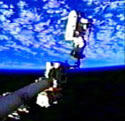
Image credit: NASA
Endeavour Astronauts Franklin Chang-D?az and Philippe Perrin performed a 7-hour, 14-minute spacewalk on Sunday, completing all the tasks on their plate. The astronauts installed a Power and Data Grapple Fixture to the station?s P6 truss, which will be used as a handle to move the truss around in the future. They also retrieved micrometeorite shields from the shuttle, which will be installed in July. Finally, the took a look at a gyroscope that recently failed on the station to help determine what might have caused it to malfunction.
Endeavour Astronauts Franklin Chang-D?az and Philippe Perrin completed all scheduled International Space Station assembly tasks today during a 7-hour, 14-minute spacewalk, the first ever for the duo.
Chang-D?az and Perrin ventured outside the station?s Quest airlock at 10:27 a.m. Central time. With the help of Endeavour Pilot Paul Lockhart, who guided the spacewalk from inside the shuttle, Chang-D?az and Perrin first installed a Power and Data Grapple Fixture to the station?s P6 truss. The fixture will be used to relocate the P6 truss structure to its final location on the station.
Attached to a foot restraint at the end of the station?s robotic arm, Canadarm2, operated by Expedition Five Flight Engineer Peggy Whitson and ISS Commander Valery Korzun, Chang-D?az gathered six micrometeoroid debris shields from the shuttle cargo bay and, with help from Perrin, temporarily stored them on Pressurized Mating Adapter-1 which links Unity to Zarya. Whitson and Korzun will install the shields on the Zvezda Service Module during a spacewalk set for late July.
Chang-D?az then conducted a visual and photographic inspection of one of the station?s four control moment gyroscopes on the station?s Z1 truss, a task that was added to today?s spacewalk after the gyroscope experienced a mechanical failure yesterday. The photos may help ground controllers better understand why the gyroscope failed.
Removal of thermal blankets from the Mobile Remote Servicer Base System or MBS was the final task of the spacewalk. At 5:21 p.m. Endeavour Commander Ken Cockrell commanded the release of latches that had secured the MBS to its carrier in the payload bay. Whitson and Carl Walz then latched onto the MBS with Canadarm2, removed it from its carrier, and maneuvered it to a position about three feet above the station?s railcar, the Mobile Transporter. Canadarm2 will be left in a parked position overnight to thermally condition the MBS before it is mated to the railcar Monday.
Later, the Canadarm2 robotic arm will be commanded to ?walk off? its position attached to the Destiny Laboratory onto a Power and Data Grapple Fixture atop the MBS. The arm will then be able to move up and down along the station truss for use in future assembly operations.
Following an inventory of the tools they used during the spacewalk, Perrin and Chang-D?az re-entered Quest. Airlock repressurization began at 5:41 p.m. Central time, signaling the end of the spacewalk. The next STS-111 status report will be issued Monday morning, or earlier, if events warrant.
Original Source: NASA News Release
Endeavour Docks with Station
The space shuttle Endeavour linked up with the International Space Station, providing supplies and a new crew – Expedition 5. Docking occurred at 1625 GMT (12:25pm EDT), slightly behind schedule because the shuttle approached the station more slowly than planned.
